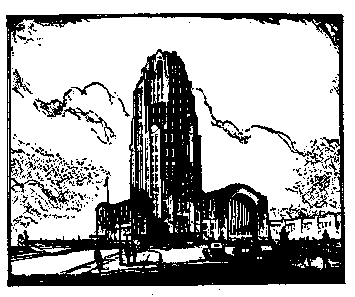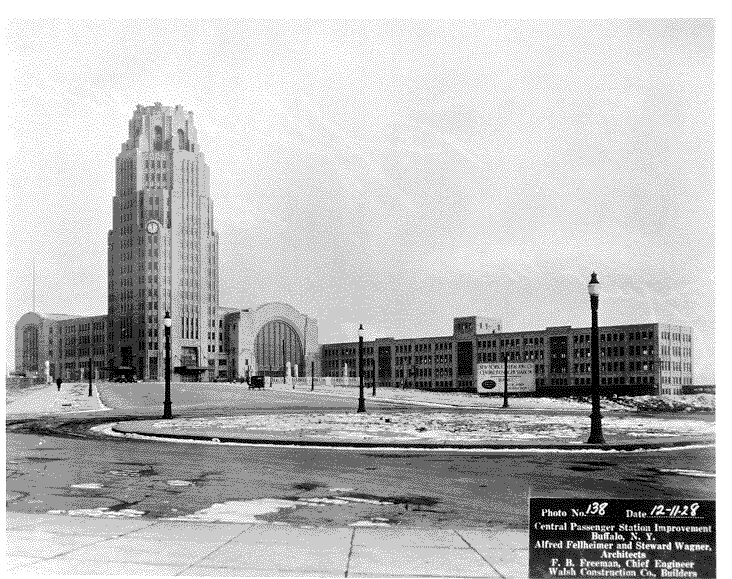Buffalo, NY
photos
by the author
The Station Too Late, Too Far
Buffalo, NY�s New York Central, "Central Terminal" is
now some 70 years old. Although the building no longer serves as a
railroad station, and it�s future is hanging in the balance, there is
reason for hope. The structure is now in the hands of a preservation
group, but they face a long term monumental task of bringing back life
to the Buffalo landmark. In October 1999, the group has succeeded in
re-lighting the tower�s signature Art Deco clocks at night. This marks
a small but significant start to a hoped for long term restoration.
Buffalo was called the Station Too Late because it opened just
before the Great Depression; Too Far because it was located too far from
the central city business district. When the age of the passenger train
died, so did the need for stations all across this country.
Notwithstanding, Central Terminal is a significant example of the
great age of railroad station construction. Central Terminal needs to be
considered in conjunction with the other major engineering efforts
undertaken by the New York Central Railroad in the 1920's and early
1930's. These included the Castleton Bridge and cutoff (1924), the
Cleveland Union Terminal (1930), Cincinnati Union Terminal (1933) and
the Hudson 4-6-4 steam locomotive (1927). These and many other
contributions by the Central to its physical plant were accomplished in
a golden period of the railroad era. The 1920�s were a time of great
changes. The railroad was still the primary passenger carrier, and the
New York Central was at the top of the list. Thus were born the
optimistic plans and Central Terminal was constructed.

An artist rendering of Central Terminal as
it was envisioned about 1926.
The railroad came to Western New York in 1842. By this time,
Buffalo had already established itself as a gateway to the west, being
the terminus of the Erie Canal. Great Lakes shipping in those days
before the Welland Canal would bypass Niagara Falls, started and ended
in Buffalo. The railroad quickly assumed a prominent position as a part
of the commercial life of the city.
In 1848 the first recorded station was constructed on what would
become known as Exchange Street. Later, another depot was built in 1855
and served through the Civil War. Abraham Lincoln stopped here in 1861.
The station saw the tragedy of Lincoln's funeral train when it paused on
April 26, 1865 following his assassination.
The New York Central & Hudson River Railroad's next Exchange
Street station was actually built in various stages over many years
starting in 1870. It was enlarged several times with the exponential
growth in rail passenger traffic until the turn of the century. For the
Buffalo Pan American Exposition, the railroad made two additions, in
1900 and 1901. Even with the additions, the station was inadequate.
Buffalo would limp along with Exchange Street through the First World
War. In the meantime, the Delaware, Lackawanna, and Western and the
Lehigh Valley railroads erected modern stations near the foot of Main
Street in downtown. The Erie Railroad had their own facility at Exchange
St. and Michigan Ave. (All of these stations have been demolished.)
In 1927, Buffalo was second only to Chicago in rail terms. Buffalo
was an industrial behemoth. With 13 trunk line railways it was a major
transportation hub of the Northeast. The New York Central was the
dominant carrier in passenger and express traffic. Buffalo was at the
midpoint on the line and in the 1920's the city reached its peak of
industrial might. Buffalo was a vital link in rail and Great Lakes
transportation.
After many years of agitation and haggling over the concept and
location for a union station, and of getting railroad participation, an
agreement was reached in June of 1925 to construct a new station in East
Buffalo for the New York Central. Located at the junction of the main
line with the Belt Line, the new station was designed to act as hub of a
greater metropolitan area. The location was once the site of the
Central's stockyards, and already had a large freight facility. The site
was controversial from the beginning. The railroad argued it had no
other choice because of very limited real estate in the downtown area.
Construction started in April 1926 with an underpass at William
St. Throughout 1927 and 1928, construction progressed on the new
station. It had been planned to open the station in late 1928. However,
the interior, especially the tile ceilings were incomplete. It would be
another 6 months before all was ready. A new downtown station was
planned for construction after Central Terminal opened to replace the
woefully inadequate Exchange Street facility. (Interestingly, this small
station was not built until the early 1950�s. By then, it was evident
that passenger trains were on the decline. The new Exchange St. station
would see it�s own decline, closing, abandonment, and later
resurrection as Buffalo�s downtown Amtrak stop. This station does not
serve the only remaining east-west train through Buffalo, the Lake Shore
Limited.)

Throughout the winter of 1928 the contractors labored. By spring,
1929 it was nearly completed. What a sight it was to behold. The
architects choose the Art Deco style for Buffalo's new temple to
transportation. Stewart Wagner and Alfred Felheimer, who would a few
years later design Cincinnati's Art Deco masterpiece Union Terminal,
created a city within itself. A 15-story office tower dominated the east
side skyline. Even today, if one overlooks the urban decay, the east
side landscape of European style church spires and Central Terminal is
impressive. A 450-foot long train concourse served 14 passenger tracks.
A unique feature was the use of ramps for arriving passengers to reach
the concourse. Rounded end canopies on the platforms would be repeated
by the architects in Cincinnati. The station, its offices and adjacent
complex would house over 1500 Central employees in 1929.
The size of the complex was enormous. The site encompassed not
only the passenger station, but also an REA express facility, an office
wing, power plant, coach shop, and two signal towers, 48 and 49 on the
east and west sides, respectively. (The towers have been removed.)
Within the junction of the Belt Line with the mainline was located the
power house and steam heating plant. Central Terminal was built to serve
a railroad that in 1930 fielded some 200 passenger trains a day into and
out of Buffalo. The Central lavished 14 million pre-depression dollars
on the construction. Central Terminal was the largest wholly owned
station on the railroad. Perhaps with the exception of Grand Central
Terminal in New York, the Great Steel Fleet had no finer place at which
to call in 1929.